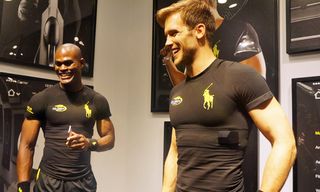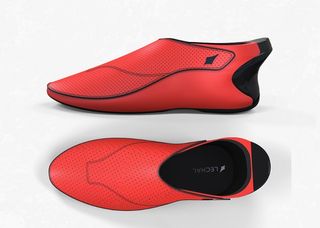Why Smart Clothing Will Kill the Fitness Tracker Wristband
Smart shirts and shoes with built-in biometric sensors will eliminate the need for clunky wristbands, and upending the fitness tracker market.

Jawbone, Fitbit, Misfit — your days are numbered. The era of the fitness wristband may already be over. The next generation of fitness gadgets is already here, as companies figure out ways to incorporate all the sensors used to track your movement into things you're already wearing.
Why wear an extra piece of equipment, and a geeky one at that, if you can get something that's already built into your clothing?
The splashiest example of this is the Ralph Lauren Polo Tech smart shirt, which uses silver fibers to measure your heart rate and breathing. It then sends those measures to a small dongle, which relays the information to your phone.
The ball boys at the U.S. Open, as well as one of the tennis players, are testing out the shirts. While in their early stages, the smart shirts will be able to tell coaches which athletes are overexerting themselves, to help better shape workouts and training sessions.
MORE: 10 Best Ad Blockers
The shirts should make their way to the public by spring of 2015. However, Polo is essentially rebranding the OM Signal smart shirts, which you can currently pre-order at $189.

Another company, Hexoskin, has a similar idea. Sensors built into that company's smart shirt measure heart and breathing rates, giving a more accurate picture of your overall fitness than heart rate and movement alone can provide.
Several companies are focusing on gear worn further down your body, experimenting with socks, insoles and shoes with embedded sensors. The technology can be applied to everything from running to helping the blind navigate.
Sensoria's $199 smart socks have small sensors that can detect where a person is exerting the most pressure, which will help determine if you're landing too hard on your heel or the front part of your foot. According to the company's website, these socks were due to ship at the end of the summer.
Also running in this space is a startup called Boogio, which uses insoles with four embedded sensors that can each detect more than 65,000 levels of sensitivity. This can be used to diagnose an athlete's stride; additionally, by shifting their weight, wearers can use the sensors to control games, said Jose Torres, the company’s CEO. Boogio is hoping to ship beta kits to developers for $189 in early 2015.

Lechal is taking things one step further. Its haptic shoes and inserts (available for pre-order for $150) will sync up with an app, such as Google Maps, and tell the wearer when to turn by gently buzzing. Also, wearers can control apps by turning the shoes one way or another, similar to Boogio's technology.
I've tested a number of fitness gadgets, and even the ones I like the most, I don't want to wear day in and day out. Truly wearable tech blends seamlessly into things I already wear. It not only makes it more convenient for those who wear the tech, but makes the tech more effective, as it can collect much more meaningful data than can accelerometers and gyroscopes. And that could mean all the difference between a gadget you wear for a month and one you wear for life.
Sign up to get the BEST of Tom’s Guide direct to your inbox.
Upgrade your life with a daily dose of the biggest tech news, lifestyle hacks and our curated analysis. Be the first to know about cutting-edge gadgets and the hottest deals.

Michael A. Prospero is the U.S. Editor-in-Chief for Tom’s Guide. He oversees all evergreen content and oversees the Homes, Smart Home, and Fitness/Wearables categories for the site. In his spare time, he also tests out the latest drones, electric scooters, and smart home gadgets, such as video doorbells. Before his tenure at Tom's Guide, he was the Reviews Editor for Laptop Magazine, a reporter at Fast Company, the Times of Trenton, and, many eons back, an intern at George magazine. He received his undergraduate degree from Boston College, where he worked on the campus newspaper The Heights, and then attended the Columbia University school of Journalism. When he’s not testing out the latest running watch, electric scooter, or skiing or training for a marathon, he’s probably using the latest sous vide machine, smoker, or pizza oven, to the delight — or chagrin — of his family.
